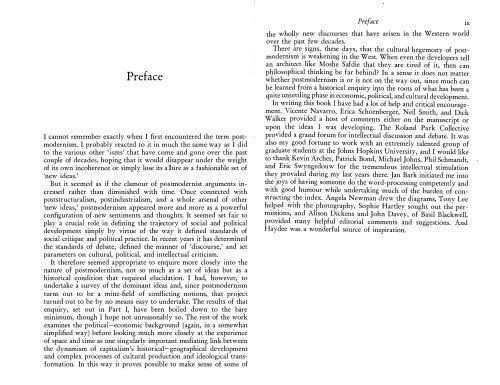The Condition of Postmodernity 13 - autonomous learning
The Condition of Postmodernity 13 - autonomous learning
The Condition of Postmodernity 13 - autonomous learning
You also want an ePaper? Increase the reach of your titles
YUMPU automatically turns print PDFs into web optimized ePapers that Google loves.
PrefaceI cannot remember exactly when I first encountered the term postmodernism.I probably reacted to it in much the same way as I didto the various other 'isms' that have come and gone over the pastcouple <strong>of</strong> decades, hoping that it would disappear under the weight<strong>of</strong> its own incoherence or simply lose its allure as a fashionable set <strong>of</strong>'new ideas.'But it seemed as if the clamour <strong>of</strong> postmodernist arguments increasedrather than diminished with time. Once connected withpoststructuralism, postindustrialism, and a whole arsenal <strong>of</strong> other'new ideas,' postmodernism appeared more and more as a powerfulconfiguration <strong>of</strong> new sentiments and thoughts. It seemed set fair toplay a crucial role in defining the trajectory <strong>of</strong> social and politicaldevelopment simply by virtue <strong>of</strong> the way it defined standards <strong>of</strong>social critique and political practice. In recent years it has determinedthe standards <strong>of</strong> debate, defined the manner <strong>of</strong> 'discourse,' and setparameters on cultural, political, and intellectual criticism.It therefore seemed appropriate to enquire more closely into thenature <strong>of</strong> postmodernism, not so much as a set <strong>of</strong> ideas but as ahistorical condition that required elucidation. I had, however, toundertake a survey <strong>of</strong> the dominant ideas and, since postmodernismturns out to be a mine-field <strong>of</strong> conflicting notions, that projectturned out to be by no means easy to undertake. <strong>The</strong> results <strong>of</strong> thatenquiry, set out in Part I, have been boiled down to the bareminimum, though I hope not unreasonably so. <strong>The</strong> rest <strong>of</strong> the workexamines the political-economic background (again, in a somewhatsimplified way) before looking much more closely at the experience<strong>of</strong> space and time as one singularly important mediating link betweenthe dynamism <strong>of</strong> capitalism's historical-geographical developmentand complex processes <strong>of</strong> cultural production and ideological transformation.In this way it proves possible to make sense <strong>of</strong> some <strong>of</strong>Prefacethe wholly new discourses that have ansen m the Western worldover the past few decades.<strong>The</strong>re are signs, these days, that the cultural hegemony <strong>of</strong> postmodernsmis ẉeakening in th. e West. When even the developers tellan archItect hke Moshe Safdie that they are tired <strong>of</strong> it, then canphilosophical thinking be far behind? In a sense it does not matterwhether postmodernism is or is not on the way out, since much canbe learned from a historical enquiry into the roots <strong>of</strong> what has been aquite un : ttling .phase in economic, political, and cultural development.In wnmg thIS book I havẹ had a lot <strong>of</strong> help and critical encouragement.Vicent Navarro, Enca Schoenberger, Neil Smith, and DickWalker pr vIded a host <strong>of</strong> comments either on the manuscript orupon the Ideas I was developing. <strong>The</strong> Roland Park Collectiveprovided a grand forum for intellectual discussion and debate. It wasalso my good fortune to work with an extremely talented group <strong>of</strong>graduate students at the Johns Hopkins University, and I would liketo than Kevin Archer, Patrick Bond, Michael Johns, Phil Schmandt,and Enc Swyngedouw for the tremendous intellectual stimulationthey provided during my last years there. Jan Bark initiated me intothẹ joys <strong>of</strong> having some::m e do the word-processing competently andWIth good humour whIle undertaking much <strong>of</strong> the burden <strong>of</strong> constructing: he index. Angela Newman drew the diagrams, Tony Leeh lp d WIth the photogṛaphy, Sophie Hartley sought out the permIssl.ons, and Ahson DIckens and John Davey, <strong>of</strong> Basil Blackwell,prOVIded many helpful editorial comments and suggestions. AndHaydee was a wonderful source <strong>of</strong> inspiration.IX
















